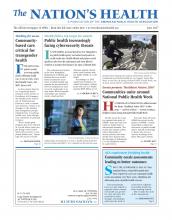Vacillating weather conditions resulting from climate change are degrading the quality of water supplies in the Midwest, according to a study published in Biogeochemistry in March.
The phenomenon of “weather whiplash,” or extreme back-and-forth periods of drought and flood, influences levels of nitrogen in soil. In times of drought, high concentrations of nitrogen in fertilizer remain in soil because not enough water is available to wash it away. But in flood conditions, nitrogen is washed into surface waters that feed into drinking supplies.
Looking at the weather whiplash that occurred from 2012 to 2013 in the Midwest, researchers determined a relationship between extreme weather variations and water quality in agricultural regions, with increased nitrogen in surface waters.
“Climate change is deteriorating water quality in a region that’s already grappling with water quality issues,” lead study author Terry Loecke, PhD, MS, assistant professor of environmental studies at the University of Kansas, told The Nation’s Health. “It has a lot of implications for how we sustain ourselves and how we sustain our communities.”
Removing nitrogen from water supplies takes significant time and energy, and systems to carry out such measures are not particularly efficient.
“When a water treatment facility removes nitrate from the water, it dumps nitrate back into the river — It has to go somewhere,” Loecke said. “It doesn’t make the problem worse, (but) it doesn’t make it any better.”
Nitrate removal plants also come at a heavy cost. For example, the Des Moines Water Works’ $4.1 million plant, constructed to remove high levels of nitrate in the Des Moines and Raccoon rivers in Iowa, has a daily operating cost of $7,000.
According to the study, economic factors are driving the boom in U.S. agriculture. But lacking restraint within the industry, farmers may be prompted to use more fertilizer to keep up with weather-related and agricultural pressures, causing further harm to the environment.
Both rural and urban consumers have a role in curbing the environmental degradation that results from weather whiplash, according to Loecke. They must understand that climate change has a direct impact on their lives, and that the problem is only going to get worse, as weather whiplash is projected to intensify with climate change. He said consumers can also make a difference through their purchasing power.
“(It) is up to consumers to show farmers that they care about the environment,” Loecke said. “If the consumers choose to purchase food that is grown more sustainably, then farmers will respond to that market and grow food more sustainably.”
For more information, visit https://link.springer.com/article/10.1007%2Fs10533-017-0315-z.
- Copyright The Nation’s Health, American Public Health Association









